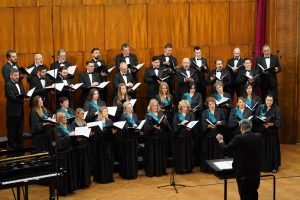Muzički limbo
Muzička kritika i napisi o muzici

Gadjiev: From Virtuoso to Storyteller – The Architecture of Sound at the 14th Chopin Fest
The recital of Alexander Gadjiev, held in the Belgrade Philharmonic Hall, represented a fine example of a virtuoso maturing into a fully-fledged artist. His pianism encompasses technical precision, intellectual depth, and the expression of refinedly constructed characters. Throughout this pianist’s performance, one could discern a desire for a deeply profound narrative, woven from a dense structural tapestry that, in terms of programmatic concept, formed a powerful whole. From Schubert to Prokofiev, Gadjiev led us through an enormous wealth of content along an ascending line—from tender lyricism to uncompromising toccata-like drive. With this recital, the 14th Chopin Fest gained a concert that undoubtedly set high standards and confirmed its international renown.
Three of Franz Schubert’s Impromptus from Opus 142—in F minor, A-flat major, and B-flat major—were performed with precisely formed characters. In the first of these, dialogues within different registers were realized in an impressive manner. The entire interpretation succeeded in depicting the melancholic disquiet typical of Schubert’s immediate past—the music of the second half of the 18th century—but with phrasing that Gadjiev directed towards uninterrupted extensions of the melodies. Instead of merely listing numerous sentence fragments, this pianist constructed wholes, seemingly with unusual ease, thus succeeding in achieving a refined lyricism. In the other two Impromptus as well, he achieved an interpretation that, in its overall sound, felt like a single, sung melody.
Generally speaking, melodiousness is an outstanding quality of his interpretive approach. For instance, the singing quality of the A-flat major and B-flat major Impromptus was achieved at the very beginning with utmost serenity. In the former, the solemn character and lightness were highlighted in a sublime way, yet this lightness was not displayed as mere decoration. This could be strongly and emotionally experienced through the contrasting oppositions of piano-forte and major-minor. The latter began like a lied, with elegant phrasing and an always clearly articulated melody that is constantly varied and carried through a texture that can often be complex in Schubert.
Frédéric Chopin’s Ballade No. 4 in F minor was an example of a well-organized interpretation of a composition known for countless excellent performances. Above all, this refers to the masterfully achieved balance between the parts, which some pianists tend to separate into decorative and essential sections. Although highlighting the melody and a singing quality is one of the main features of Gadjiev’s performance, it seemed that every so-called secondary part served to achieve the most pronounced emotional effect, with temporary releases achieved in the powerful climaxes of the ballade. He achieved all of this without false pathos or muddying the passages, and with extremely discreet use of the right pedal.
This final point certainly recalls the interpretation of Maurizio Pollini, though the intensity is more strongly emphasized in Gadjiev’s playing. Perhaps we could compare his deep emotionality without sentimentality to the playing of Claudio Arrau. Drawing such a comparison actually highlights the uniqueness of Gadžijev’s interpretation, who, at the same time, succeeded in realizing the Rubinstein-esque ideal of organic connection and balanced interpretation precisely through the clarity of the melodic line and phrasing.
Pyotr Ilyich Tchaikovsky’s Dumka was interpreted in a similar fashion. The dark and melancholic tone, intoned with a rubato that served to emphasize the work’s narrative character at the very beginning, was set as a stark contrast to the rhythmically precise village dance in the composition’s middle section. Again, in the performance of this piece, we must emphasize the skillful use of pedaling, which, for Gadjiev, serves to encourage an orchestral sound and depth, especially at the beginning of the composition.
The final part of the concert began with Sergei Prokofiev’s Legend, Opus 12 No. 6. What was done effectively was the connection of this piece, permeated with mysticism, to the explosive beginning of the composer’s Sonata No. 7, in such a way that the pause and transition to the next work felt organically linked. This fact certainly indicates that Gadžijev’s priority was a well-formed narrative, in this case achieved with strongly underlined contrasting characters. The depth of tone achieved in the Legend was fascinating, primarily because the dissonance was polished to a level of mystery and dreaminess. The slow tempo and elegiac character, combined with long phrasing and the skillful maintenance of a quiet narrative line that incorporated all the textural glints added to the melody moving in unforeseen directions, are truly a sign of the artist’s maturity.
We experienced the dramatic culmination of the concert with the performance of the Seventh Sonata. The sharp and strongly intoned rhythmic lines of the first movement, with a hard and aggressive tone, were indeed directed towards treating the instrument as percussion. Nevertheless, all this richness—composed of harmonic dissonances, fast moving lines, and brief lyrical resting points which, in Gadjiev’s playing, seem more like sarcastic comments than places of repose—was all organized into a continuous statement.
As another strong contrast, the melody of the second movement was highlighted, possessing something of a Chopin-like singing quality, or at least the kind of longing that Prokofiev achieved in the ballet Romeo and Juliet. Through Gadjiev’s playing, the three-part, reprise structure of the movement could be clearly discerned, within which the pianist succeeded in maintaining the listener’s attention despite the slow tempo. In fact, the dynamic control was built in such a way that the movement’s culmination, with strongly underlined chords, acted as a genuine outpouring of grief, expressed through a unique fusion of Romantic lyricism and Modernist dissonance.
The third movement of the sonata is known as one of the most demanding in Prokofiev’s piano literature. Precisely through the strictly controlled mixed rhythm, which requires mechanical execution, Gadjiev managed to achieve an effect of might and unbridled force. Although the entire movement is characterized by extreme toccata-like quality and speed, the climaxes were masterfully realized, emerging as a result of the controlled dosage of energetic charge. In his sovereign performance of the countless passages of the uncompromising sonata finale, the artist demonstrated supreme technique and machine-like precision.
The playing styles of young pianists like Gadjiev are difficult to compare directly with legendary figures. Given that he possesses the quality of achieving a full tone even in the quietest passages, perhaps we could draw a parallel with the interpretation of Radu Lupu because of the warmth and sensibility he expresses. The analytical and considered architectural approach to interpretation seems to point to Sviatoslav Richter, while the comprehensively connected forms, singing phrasing, and refined lyricism might speak of Artur Rubinstein. This comparison certainly serves to emphasize the importance of a unique pianistic figure such as Aleksander Gadjiev. He is a distinctive artist who has brought the art of interpretation to a high level.







